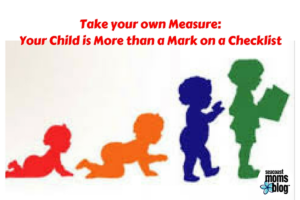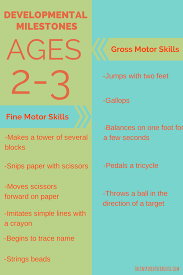 If you are concerned about your child’s development, there are plenty of checklists on the Internet that can scare you into thinking your child is way behind. There are the CDC’s Developmental Milestones checklists, growth charts, and a myriad of other measurement tools aimed to gauge where your child is at for his or her age. And there’s also the Modified Checklist for Autism in Toddlers, Revised (M-CHAT-R™).
If you are concerned about your child’s development, there are plenty of checklists on the Internet that can scare you into thinking your child is way behind. There are the CDC’s Developmental Milestones checklists, growth charts, and a myriad of other measurement tools aimed to gauge where your child is at for his or her age. And there’s also the Modified Checklist for Autism in Toddlers, Revised (M-CHAT-R™).
Sometimes you stumble across milestone checklists on the Internet. Or you fill them out at day care or in a medical specialist’s office. Each checklist I’ve ever encountered has caused me anxiety and anguish; and now I am learning to ignore these lists in favor of my gut.
The checklist roller coaster began with my child’s head circumference measurement. Apparently it was so large, it was growing off the charts.
We knew our son already had brachycephaly, or flattening in the back of his head. This meant he would wear a corrective helmet to adjust the flatness of his head for up to six months. But the circumference issue posed another new twist. “What does that mean?” Doctors said that we had to keep an eye on it. Eventually, Everett grew into his head.
Next, we became concerned that Everett couldn’t roll over at age seven months.
(I now blame his enormous head). Early intervention sent over a series of checklists for us to fill out to gauge whether or not he was developmentally behind. After an hour-long evaluation, we discovered he did not qualify for services, but I was cautioned to have him re-evaluated in the future. Every night before I fell asleep, I wondered what future checklist would reveal new or widening deficits.
When he was not walking at 11 months, we contacted a private physical therapy outfit that conducted a full evaluation, complete with more checklists.
The therapists were concerned with his balance and “low muscle tone.” Needless to say, I was sick to my stomach and suffered sleepless nights concerned about what that might mean. They even convinced us to combine speech therapy with PT. Then, they asked us to consider having him evaluated by a developmental pediatrician or a neurologist. By the way, Everett was walking just fine at 13 months; running at 14 months. We never did visit a neurologist. And after witnessing a few “speech therapy” sessions that were held in concert with the PT, we realized it was way too early for a child that young to really benefit. I cancelled both services after a few months. I settled down and decided to trust my gut for once.
At around 18 months, Everett was only saying a few words, so I opted to participate in a free speech and language screening.
Maybe I had been wrong about cancelling speech at age 14 months? Perhaps these checklists and the professionals who administered them were on to something. The speech and language pathologist screener had me fill out more checklists and sounded the alarm. Everett needed speech therapy immediately. My stomach in knots, I shed tears in the car. That week, I engaged a private speech therapist to help us out.
I engaged a private speech therapist to help us out.
We did participate in weekly speech therapy from about age 20 months to 26 months. Everett graduated out of the program earlier this winter with little explanation as to “why” he improved after several 30-minute-long sessions. And really, I can’t say that I credit speech therapy to improving my son’s vocabulary or sentence construction. Instead, I credit 80 percent of his language leap to a new preschool I enrolled him in at age 23 months. He was the youngest student in his class and absorbed a ton from his older classmates between October and December. And, he attended preschool about 35 hours a week.
I know checklists serve a great purpose. Really, who wants their child left behind?
And isn’t it a great way for parents, educators, and medical providers to match kids with the right intervention services before it’s too late? It’s really important to work closely with your pediatrician and child care providers if you have any concerns. And by all means, leave no stone unturned. But for me and likely other parents, these milestone charts can cause more worry than is necessary. It’s great there’s so much awareness and education related to child development. Still, children achieve milestones at different times. But maybe it’s time to stop measuring kids so young and start letting them grow at their own pace.










